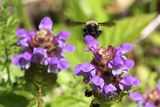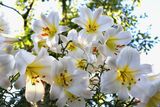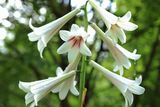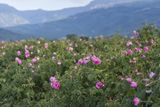Diascias - small but beautiful
Diascias are perfect for containers or a flower bed
Diascia is in flower these days in containers and in the open ground of gardens. It is a small plant and could be easily passed over if it weren't for its tremendous show of flowers. The flowers are small, about two centimetres across at best. They are tubular and flaring at the mouth, a bit like foxgloves, to which they are related, though smaller and shorter.
The small flowers are carried on loose flower spikes of a dozen or more, each flower held on a wiry stem. The flower spikes cover the leaves when in full flower in early summer. The peak of flowering is followed by less numerous, occasional flushes, although some kinds do not give many late flowers.
Until a decade or so ago, there were just two kinds of diascia in gardens, the smaller Diascia barberae as described, and the much larger, more common Diascia rigescens. While the latter has declined, the former kind and its hybrids have taken off. The first was a variety called 'Ruby Field', one of the Barberae types, small with masses of nice red-pink flowers.
'Lilac Belle' is a delightful variety with lilac-pink flowers. 'Salmon Supreme' has a salmon-pink colour with a touch of apricot, a lovely variety. 'Blackthorn Apricot' is low-growing, spreading with apricot-pink flowers that can have a touch of orange. 'Little Dancer' is compact with bright pink flowers and has been joined by a series of similar, such as 'Little Dazzler' and 'Little Dreamer'. 'Flamingo' is soft pink. 'Coral' is red pink. 'Hopley's' is light blue-purple. 'Blue Bell' is blue and 'Snow' is white. The variety names change all the time as new named kinds are bred and commercialised, but there is always a good choice.
Many of the new kinds have larger flowers, often carried more densely on shorter stems, spreading slowly outwards to form a dense, low-growing mat. Because different species have been used in the hybrids, the varieties differ in their growth habit, some taller or looser or with more tightly held flower spikes, earlier or later to flower. Some kinds suit some gardens better than others and others suit containers. Although diascias are not completely hardy, the newer kinds have been bred for hardiness and will survive in most gardens in all but the hardest winters.
Most kinds of diascia have quite good weed resistance because of their dense ground-hugging growth, some kinds producing underground stems. Even though many are not taller than about 25cm and of light growth, they manage to swamp seedling weeds with vigorous growth. They really need just a tidy-up clip-over of the dead flower stems at the end of the flowering season.
Q: My lupins are currently magnificent but I noticed today that they are covered in whitefly. Is there anything I can use that will not affect bees or other wildlife?
E Fahey, Roscommon
A: Very common this summer, these are greenflies, and they leave their white skins behind as they moult. This species only affects lupins - but can do so very severely, causing flower stems to collapse. A spray of water reduces numbers but they build up again. Bees visit lupins for nectar and pollen. Organic insecticides work by contact, killing only the greenflies they hit, and the greenflies can be thoroughly sprayed in the late evening when the bees are back in their hive.
Join the Irish Independent WhatsApp channel
Stay up to date with all the latest news














